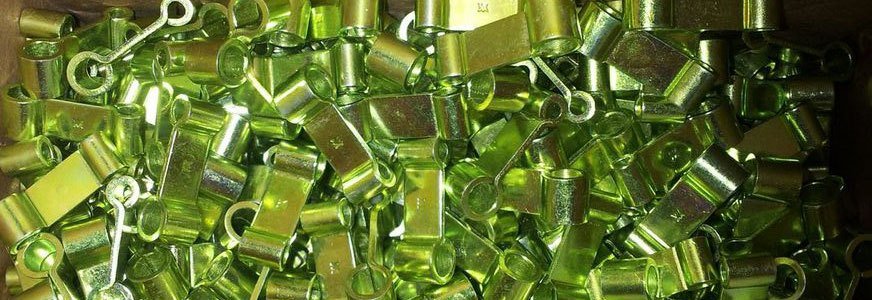Zinc is a hard, brittle metal that is found in abundance in many parts of the world. Zinc electroplating offers an inexpensive alternative to precious metals such as gold, silver and platinum. Its relatively low cost makes the zinc plating process the top choice for companies looking for affordable corrosion protection. The zinc acts as a sacrificial barrier coating that prevents oxidation of the underlying substrate. Addition corrosion protection can be achieved by applying organic top coats and passivation treatments to the zinc. SPC Does not provide hexavalent chromate/passivate (i.e. yellow chromate)
While zinc plating yields a silvery-gray finish, the color can be altered through passivation. Zinc passivates may be yellow, black or clear blue, and the application of lacquers can provide a protective seal. Zinc plating can be used with virtually any type of metal, but is most frequently applied to iron or steel surfaces. Typical zinc electroplating applications include coating nuts, bolts, washers and various automotive parts.
Other common zinc plating uses include the production of electrical transmission components and plating fasteners. The defense industry relies on zinc plating in the manufacturing of tanks and armored personnel carriers.
Zinc Alloy Plating
Zinc is often alloyed with other metals in the plating process, most commonly nickel and tin. A zinc-nickel alloy provides 10 times greater corrosion protection than zinc alone. The application of top coats and passivation treatments improves the performance of the finish and can exceed even the most demanding standards. A tin-zinc alloy also provides an effective safeguard against corrosion and is sometimes used as an alternative to cadmium plating. Other common uses of zinc alloys include zinc-iron and zinc-cobalt.
Important Zinc Plating Benefits
Zinc is compatible with various plating bath chemistries, making it one of the more versatile metals for electroplating purposes. Zinc is also amenable to both rack plating and barrel plating processes. Zinc’s temperature tolerance can reach as high as 120 ° F, which helps to reduce cooling costs in the zinc plating process. A zinc coating is susceptible to hydrogen embrittlement, which can cause fracturing when metals are exposed to hydrogen. Zinc also offers excellent adhesion and ductility.
Zinc Plating Process Highlights
Zinc electroplating can be executed with cyanide-based, alkaline cyanide-free, or acid zinc electrolyte baths. The first two options are preferable for providing suitable thickness distribution on larger or more complex parts. Barrel plating is recommended for coating smaller objects such as nuts and bolts.
When to Avoid Zinc Plating
One drawback of plating with zinc is that zinc coatings do not hold up well against acids or alkalis. In these situations, powder, plastic or e-coat is a better option. Exposure to seawater can also limit zinc’s durability, making it a poor choice for desalination and other marine applications. The thickness of the zinc coating is often inconsistent and can vary significantly depending on the shape of the substrate.
Contact SPC to Learn More About the Benefits and Uses of Zinc Electroplating
Is our zinc plating service the best of our industrial metal finishing options for your business? Contact the experts at Sharretts Plating Company to find out for sure. Few zinc plating companies can match our knowledge and experience. We’ll be happy to put our more than 80 years of industrial metal finishing experience to work for you. At SPC, we’re perfectly positioned to be your long-term plating and finishing partner, and we would be proud to be your zinc electroplating company!




